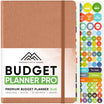Bullet journaling has taken the productivity and creativity world by storm, offering a flexible and customizable system for organizing tasks, goals, and ideas in a single notebook. Whether you're a seasoned journaler or new to the concept, mastering the art of bullet journaling can revolutionize the way you plan, organize, and track your life. In this comprehensive guide, we'll explore essential how-tos and tutorials to help you start bullet journaling like a pro.
What is Bullet Journaling?
Bullet journaling, often abbreviated as BuJo, is a method of personal organization developed by designer Ryder Carroll. At its core, bullet journaling combines elements of to-do lists, calendars, and journaling into a single system that can be adapted to suit your unique needs and preferences. The key components of a bullet journal include rapid logging, collections, and an index, allowing you to capture tasks, events, and notes in a streamlined and efficient manner.
Getting Started with Bullet Journaling
To start bullet journaling like a pro, you'll need a few essential supplies: a dot grid or blank notebook, pens or markers, and a ruler. Begin by setting up the basic framework of your bullet journal, including an index page to track your collections, a future log for long-term planning, and a monthly log for upcoming events and tasks. From there, you can customize your journal with additional spreads, such as habit trackers, goal pages, and reflection prompts, to suit your individual needs and goals.
Essential Bullet Journaling Techniques
Mastering the art of bullet journaling requires familiarity with a few essential techniques:
- Rapid Logging: Use symbols and shorthand notation to quickly capture tasks, events, and notes in your journal. Common symbols include bullets for tasks, circles for events, and dashes for notes. Experiment with different symbols and styles to find what works best for you.
- Collections: Create themed collections or spreads to organize related information, such as reading lists, meal plans, or travel itineraries. Use headers, dividers, and color coding to differentiate between collections and make them easy to reference.
- Migration: Regularly review your tasks and migrate incomplete items to the next day, week, or month as needed. This process ensures that nothing falls through the cracks and helps you stay focused on your priorities.
Advanced Bullet Journaling Tips and Tricks
Once you've mastered the basics, you can take your bullet journaling skills to the next level with advanced tips and tricks:
- Experiment with Different Spreads: Explore different types of spreads and layouts, such as weekly logs, mood trackers, and brain dump pages, to find what works best for your workflow and preferences.
- Embrace Creativity: Get creative with your bullet journal by incorporating hand-lettering, doodles, and decorative elements. Use colored pens, washi tape, and stickers to add visual interest and personality to your pages.
- Stay Consistent: Establish a regular journaling routine and make it a habit to update your bullet journal daily or weekly. Consistency is key to maximizing the effectiveness of your journal and staying organized and productive.
By mastering essential techniques, experimenting with different spreads, and embracing creativity, you can start journaling like a pro and unlock the full potential of your bullet journal. Whether you're using your journal to track tasks, set goals, or express your creativity, the possibilities are endless. So grab your notebook and pens, and start bullet journaling your way to a more organized and inspired life.




















Leave a comment
All comments are moderated before being published.
This site is protected by hCaptcha and the hCaptcha Privacy Policy and Terms of Service apply.